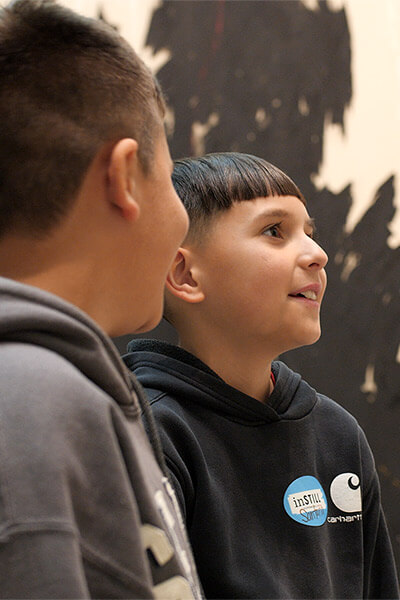By Marisa Brown, Clyfford Still Museum educator
Summary:
The purpose of this lesson is to empower students to explore their own creativity and begin the process of self-reflection by making a Creativity Toolkit. Students will reflect on what creativity means to them, the ways they are creative in their daily lives, and what fuels their creativity. Then, students will dive into art-making using these discoveries as a catalyst for creative exploration through play!
Big Idea:
- I can be creative. Creativity looks unique for each person.
Essential Questions:
- What is creativity?
- In what ways am I creative?
- What feeds my creativity?
Learning Targets:
- I can decide what creativity means to me.
- I can listen to my own creativity.
- I can explore and play.
Time:
- 45 – 60 minutes
Materials:
Standards:
Colorado Visual Arts Standards:
- Standard 3: Invent & Discover to Create
- Standard 4: Relate and Connect to Transfer
Colorado Prepared Graduates in Visual Arts:
1. See oneself as a participant in visual art and design by experiencing, viewing or making.
7. Allow imagination, curiosity and wonder to guide inquiry and research.
10. Develop new knowledge by actively doing and making (artistic praxis), acknowledging relationships between materials, objects, ideas and lived experience.
National Visual Arts Standards:
- Creating Anchor Standard 1:
- Generate and conceptualize artistic ideas and work
- Responding Anchor Standard 8:
- Interpret intent and meaning in artistic work
- Connecting Anchor Standard 10:
- Synthesize and relate knowledge and personal experiences to make art
CASEL SEL Framework:
- Self Awareness: The abilities to understand one’s own emotions, thoughts, and values and how they influence behavior across contexts.
- Self-Management: The abilities to manage one’s emotions, thoughts, and behaviors effectively in different situations and to achieve goals and aspirations.
- Responsible Decision-making: The abilities to make caring and constructive choices about personal behavior and social interactions across diverse situations.
Steps:
1. Mindfulness (5 minutes)
- Share the big idea:I can be creative. Creativity looks unique for each person. Share the targets with students: I can decide what creativity means to me. I can listen to my own creativity. I can explore and play.
- Invite students to close their eyes and imagine what their creativity looks like.
- Invite students to share what creativity means to them (pair-share/whole group)
2. Slow Looking (15 minutes)
- Facilitate slow-looking with a representational, transitional, and abstract painting. Look at each painting individually and ask:
- What is going on in this picture?
- What do you see that makes you say that?
- What does this artwork reveal about Still’s creative identity?
- (K-3): what does this artwork tell us about Still as an artist?
- What more can we find?
- Share that Clyfford Still was creative in many ways – he painted, drew, wrote, played the piano, listened to music, gardened, etc.
- His art shows how he listened to his own creativity and followed what fueled him to create more and more abstract art as his career progressed
3. Completing a Creativity Toolkit (10-15 minutes)
- Invite students to explore their own creativity through self-reflection by making a Creative Toolkit in whichever format they choose.
- Encourage students to share with each other as they work or after they finish if that feels right for their process.
4. Exploring Your Creativity (10-15 minutes)
- Share that in order to find his creative identity, Clyfford Still, like all humans had to try new things and experiment with his ideas and materials. Invite students to choose an idea or a material/medium that inspires them and allow themselves to play (you may choose a certain constraint like an artist trading card format if you have time/space limitations).
- Students may also combine multiple ideas or media to experiment with materials. Explore freely within the time constraints – it is okay if students don’t like the product – it’s all about process. Remind students to reference their Creative Toolkit if they get stuck along the way.
5. Sharing (5 minutes)
- Remind students that creativity is a lifelong endeavor. Invite them to share their creativity toolkit, their artwork and how they might use what they learned in different parts of their lives.
Differentiation:
Content:
- Choose appropriate and relevant vocabulary
- Model and provide examples
- Choose appropriate and relevant paintings
- Give Verbal descriptions of the artwork
- Use Individual reproductions of artwork to allow for close viewing
- Use Realia, objects, and other manipulatives
Process:
- Confer with and support students during work-time
- Allow for student voice and choice in all parts of the lesson
- Facilitate VTS individually, in small groups, or whole class
- Write or draw while processing/listening
- Provide sentence stems and sentence frames
- Use non-verbal participation techniques (like thumbs up/thumbs down)
- Breakdown the perceived challenge of a task by chunking
Environment:
- Allow for students to collaborate with their peers if preferred
- Allow for students to work independently if preferred
- Allow for a quiet space or breaks for students as needed
- Allow students to regulate using headphones if appropriate
Resources:
- Creativity Toolkit Download
- CSM Self-Guided Teacher Resource Slides
- Link to Clyfford Still Museum Online Collection
Examples:


